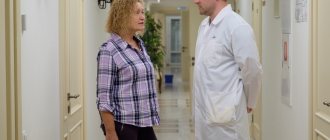One of the frequent complaints in the practice of a neurologist is neck pain (cervicalgia).
Painful sensations in the neck are typical of older people, but it is wrong to attribute the causes of cervicalgia to age-related changes. A competent neurologist knows that pain has a specific, serious underlying cause.
The widespread prevalence of neck pain does not mean that you need to endure suffering stoically. There is some truth in the fact that many people have such problems, but the statement that you should not consult a doctor for such trivial reasons is incorrect. Vice versa! In terms of anatomy, the neck plays a strategic role regarding the health of the body. Therefore, if pain in the neck occurs, you should go to a neurologist immediately. This is especially true when episodes of pain are repeated, persistent or intensified.
Statistical data from all countries of the world confirm that 25-75% of adult working citizens experience cervicalgia. The frequency of seeking medical help for this matter greatly depends on the patient’s type of activity and some associated factors. Neck pain is a serious medical problem, so it is better to play it safe and consult a neurologist so that, if necessary, timely treatment of cervicalgia can begin. Without therapy, 6-12% of patients become temporarily disabled, and some become permanently disabled.
Causes
The specialized medical literature describes in detail all sorts of root causes of neck pain, grouped into several types.
- Fractures, dislocations, injuries of the vertebrae, joints, muscles and ligaments in the neck.
- Infections that cause inflammation of bone and cartilage tissue, muscles, cervical lymph nodes and nerves (osteomyelitis, abscess, herpes zoster, etc.).
- Referring pain in diseases of the heart, lungs, stomach, esophagus, and other organs.
- Rheumatological diseases (arthritis, myalgia, fibromyalgia and others).
- Neuroendocrine pathologies.
- Nonspecific factors (hernias and displacements of intervertebral discs, problems with intervertebral joints, narrowing of the spinal canal, arthrosis, muscle spasms, osteochondrosis, problems caused by insufficient muscle activity).
- Intracranial diseases (benign or malignant brain tumors, stroke, abscess).
- Oncological tumors and metastases.
- Psychosomatics.
Forecast and prevention of the disease
It is necessary to recommend that the patient return to normal daily activities as quickly as possible, since maladaptive pain behavior is the main barrier to recovery. In addition, comorbid depression also negatively affects treatment outcomes. If pain persists for >4–6 weeks, it is advisable to add antidepressants to analgesic therapy. Pathogenetically, it is most justified to use antidepressants that act on both neurotransmitter systems (serotonin and noradrenergic) for the treatment of pain symptoms. Tricyclic antidepressants (TCAs), which block the reuptake of serotonin and norepinephrine, have greater potential than selective antidepressants. TCAs are more successful in treating pain symptoms and leading to more complete remission of depression. A new class of drugs, dual-action antidepressants that block the reuptake of serotonin and norepinephrine, have high analgesic efficacy and a more favorable spectrum of side effects than TCAs. The effectiveness/safety ratio is optimal for dual-acting antidepressants (duloxetine, venlafaxine). During the recovery period, active exercises are recommended to strengthen the muscle corset.
Symptoms
Since the nature of pain is diverse, before starting treatment for cervicalgia of the cervical spine, you need to understand the symptoms.
- Pain can appear in episodes: when standing in one uncomfortable position for a long time, from prolonged, monotonous exercise. This pain is aching in nature, causing a desire to change position and stretch a little.
- Paroxysmal pain, periodically recurring due to certain provoking factors such as acute respiratory infections, physical activity, drafts, hypothermia.
- Acute pain radiating to neighboring parts of the body. Patients describe it as a throbbing or shooting sensation.
- Local soreness of certain points on the body, which is barely perceptible at rest, but intensifies to unbearable with intense movement, eating, swallowing water or palpating.
- A feeling of partial or complete stiffness in the neck, making it difficult or completely impossible to turn or tilt the head.
The symptoms clearly described by the patient will allow the neurologist to quickly determine a preliminary diagnosis, prescribe the necessary laboratory and instrumental tests, based on the results of which treatment of cervicalgia will begin.
If you find yourself with the symptoms listed above, make an appointment with a neurologist at a medical clinic.
Make an appointment The application is preliminary. An operator will contact you to confirm your appointment.
Your application has been accepted, our specialists will contact you shortly. Thank you for contacting the medical
Classification of the disease
Over the years, changes occur in our body, for example, a baby’s skin is soft and elastic, but at 30 years old it is no longer so. The same thing The same thing happens with our spine. Degenerative and dystrophic processes in the spine contribute to the formation of protrusions and hernias, which can and do lead to radiculopathy in the future.
There are discogenic and vertebrogenic forms of the disease. Vertebrogenic radiculopathy is a secondary type of disease in which the spinal cord root is compressed in a kind of tunnel formed by various pathological processes. This may be soft tissue swelling, tumor, osteophytes, disc herniation.
As the degenerative inflammatory process develops, the tunnel narrows, indentation and severe pain appear.
Depending on the location, the following forms of radiculopathy are distinguished:
- cervical;
- lumbosacral;
- mixed.
The disease can occur in adults of any age; if left untreated, the disease can lead to disability. Another name for this disease is radicular syndrome. Complex names have not caught on among the people, so you can often hear that a person suffers from radiculitis. Although this name is not entirely correct.
The most common type is lumbosacral radiculopathy. It affects the vertebrae L5, L4, S1. To understand which vertebrae are involved in the process of inflammation, you need to remember that all parts of the spine are designated by Latin names. The sacral region is Os Sacrum, therefore, the vertebrae are designated by the letter S from 1 to 5. The lumbar region is Pars Lumbalis (L1-L5). Cervical region - Pars Cervicalis (C1-C7). Thoracic spine - Pars Thoracalis (Th1-12).
Having familiarized yourself with this classification, it is easy to understand that Th3 means damage to the third vertebra in the thoracic region, and C2 means damage to the second cervical vertebra. The level of damage is determined using an x-ray.
There is an international classification of diseases - ICD 10. It is generally accepted for coding all medical diagnoses. According to the ICD, radiculotherapy is assigned code M 54.1.
Diagnostics
An examination of a patient by a neurologist begins with listening to complaints, examination, and collecting detailed information. A neurologist needs to know what chronic diseases the patient has, what operations he has undergone. It is important to the doctor what serious illness his relatives had, and what the nature of the patient’s profession is. Particular attention is paid to the history of the appearance and changes in symptoms.
During the examination, the neurologist builds a diagnostic concept and prescribes various studies, such as x-rays, magnetic resonance and computed tomography, ultrasound, endoscopy, puncture, etc. The patient must be sent for laboratory tests. You may need the help of specialized doctors. Often, as a result of a diagnostic study, causes of cervicalgia are identified that initially no one could have thought of.
Complications of radiculopathy
In the absence of a proper approach to the treatment and prevention of this disease, radicular syndrome quickly becomes chronic. As a result, changes such as sudden movement, exposure to cold, or stress can trigger an attack of pain.
Another complication may be a persistent impairment of the motor and sensory function of the affected limb and lead to disability. For example, a hernia in the lumbar spine without timely treatment causes peripheral paresis and parylysis of the lower limb, and disrupts the function of the pelvic organs.
Treatment of cervicalgia
Even a short list of the causes, symptoms, and diagnostic methods of cervicalgia gives an idea of how complex the human neck is, an important and vulnerable organ. Therefore, the treatment of cervicalgia of the cervical spine should be trusted to certified specialists. Competent therapy is possible after a comprehensive study of the causes of the disease. The options for diagnostic examination are individual and numerous; it is not possible to list them in the article, but the truth is indisputable: a qualified doctor must prescribe and monitor treatment.
Surgery
Even minimally invasive surgery in the treatment of cervicalgia is a last resort. It is worth resorting to the help of surgeons in the absence of alternative methods of treatment. The neurologist has a clear list of absolute indications for surgery. But treatment of cervicalgia of the cervical region by other methods is used much more often. The choice of medications and their dosage is an extremely delicate process, which can be started after a thorough diagnosis.
Physiotherapy
Throughout human civilization, physiotherapy remains the main way to treat cervicalgia. This is a highly effective, reliable method of treatment, but today among the population it is unfairly underestimated in comparison with medications and operations.
In the 21st century, physiotherapy has reached previously unprecedented heights thanks to the help of high technology. Laser, manual, ultrasound and reflexology, physical therapy, massage today lead to complete cure of the most difficult cases. When prescribed correctly, these methods are very effective, but the patient will have to be persistent and patient - treatment of cervical cervicalgia requires time to achieve a stable result.
One of the most innovative areas of physiotherapy that has proven its effectiveness is tekar therapy. This technique is based on the use of high frequency currents, with the help of which electromagnetic radiation is converted into thermal energy. The heat warms problem areas on the neck, stimulating regenerative processes in the affected tissues. The influence of the tekar device helps relieve muscle spasm, as a result, the pain decreases or completely disappears after the first session of tekar therapy.
When choosing a treatment method, you need to remember that minimally invasive physiotherapeutic treatment has a logic of prescription and contraindications. Cervicalgia is a disease that must be treated by highly qualified doctors in clinics equipped with modern equipment.
Occipital neuralgia
The article was prepared by a neurologist, the chief physician of our clinic, Pavel Dmitrievich Kovzelev. In this article, in addition to a description of occipital neuralgia and the principles of treatment, you can watch a video with a clinical case from our patient, as well as a video of how an occipital nerve block is performed - one of the most effective methods of treating this pathology.
Anatomy of nerves.
The occipital nerves, 3 in number, are formed at the level of the 2-3 cervical vertebrae, then exit to the posterior surface of the spine and are located between the deep and superficial muscles of the neck.
At the level of the occipital bone, the nerves pierce the superficial muscles and exit under the skin, breaking up into small terminal branches that innervate the skin of the occipital region.
It's best to look at the picture.
Causes of neuralgia/neuropathy of the occipital nerve.
Why occipital neuralgia (also known as neuropathy) occurs is not completely clear.
The most popular hypothesis is that the nerve becomes trapped between the muscle and the fibrous tissue at the exit site and is pinched.
In people who have undergone surgery on the cervical/occipital region, people with Arnold-Chiari malformation, problems in the cervical spine, as well as those who have recently suffered a whiplash injury to the neck, NLDs are more common, which, in principle, fits into the “trap” hypothesis.
Symptoms of occipital neuralgia.
- The pain is severe, shooting, like electric shocks.
- Has a paroxysmal character: from several seconds to several minutes.
— The pain is localized in the back of the head, usually on one side and rarely on both sides.
- Between attacks, a dull, low-intensity pain may persist.
An attack can be provoked by touching certain points of the head, turning the head and any mechanical stimuli.
Sometimes patients note a decrease in sensitivity in these areas, and sometimes patients note dizziness and nausea.
IMPORTANT: Pain with occipital neuralgia can reach the fronto-ocular region through the connections of the occipital nerve with the trigeminal nerve at the level of the spinal cord.
The clinical picture may vary among patients. There are diagnostic criteria that I took from the 3rd International Classification of Headaches.
Let's look at them, but they are more important to me or your doctor.
- Unilateral or bilateral pain in the distribution of the greater, lesser and/or third occipital nerves and fulfillment of BD criteria
- Pain has at least two of the following three characteristics:
- repeated paroxysmal attacks lasting from several seconds to minutes
- heavy in intensity
- shooting, stabbing, or sharp pain
- Pain is associated with both of the following:
- dysesthesia and/or allodynia, manifested during painless stimulation of the scalp and/or hair (this is when normal touch is perceived as painful)
- one or both of the following: a) tenderness when pressing over the affected nerve branches
- b) trigger points at the origin of the greater occipital nerve or in the distribution of the C2 root.
- Pain is temporarily reduced by applying local anesthesia to the affected nerves. (i.e. when performing a blockade).
- Does not fit other diagnoses of the 3rd International Classification of Headaches.
Diagnosis of neuropathy of the occipital nerves. The diagnosis of NMN is made clinically (i.e., upon examination by a doctor), but for this it is necessary to exclude other causes. Taking into account the fact that many pathological processes in the posterior part of the brain and skull, as well as in the cervical spine, can produce similar pain in the occipital region, it is necessary to carry out:
- MRI of the brain
- MRI of the cervical spine, ultrasound examination of the vertebral arteries.
- In our clinic, ultrasound of the vessels of the head and neck is performed by a doctor with extensive experience, Irina Alekseevna Romadova, using an expert-level ultrasound device.
Treatment of neuralgia of the occipital nerves Treatment usually begins with a diagnostic blockade, which often gives a lasting positive result. I prefer to perform this block under ultrasound guidance for more precise and, more importantly, safe insertion. If necessary, the blockade can be repeated, but not more than once every three months. This is what it looks like schematically
This is how everything is visible with ultrasound navigation. I circled the nerve itself and its signature in red. It is very small, it literally looks like a dot. (Image clickable)
Drug therapy (standard drugs for neuropathic pain): gabapentin, tricyclic antidepressants, pregabalin, baclofen, carbamazepine.
of reflexology has proven itself well , which in this case is additional to stabilize and consolidate the effect.
If all of the above methods do not help, then you can: try botulinum toxin.
Also, one of my patients noted the effect of using Cefaly , a device for the treatment of migraines, which can be rented at our clinic to evaluate its effectiveness.
Neuralgia of the occipital nerves is an uncommon but extremely painful pathology. Sometimes people suffer for decades without a diagnosis or adequate treatment. At the same time, neuralgia has relatively clear diagnostic criteria and treatment approaches.
Kovzelev Pavel Dmitrievich
Chief physician, neurologist, vertebrologist







